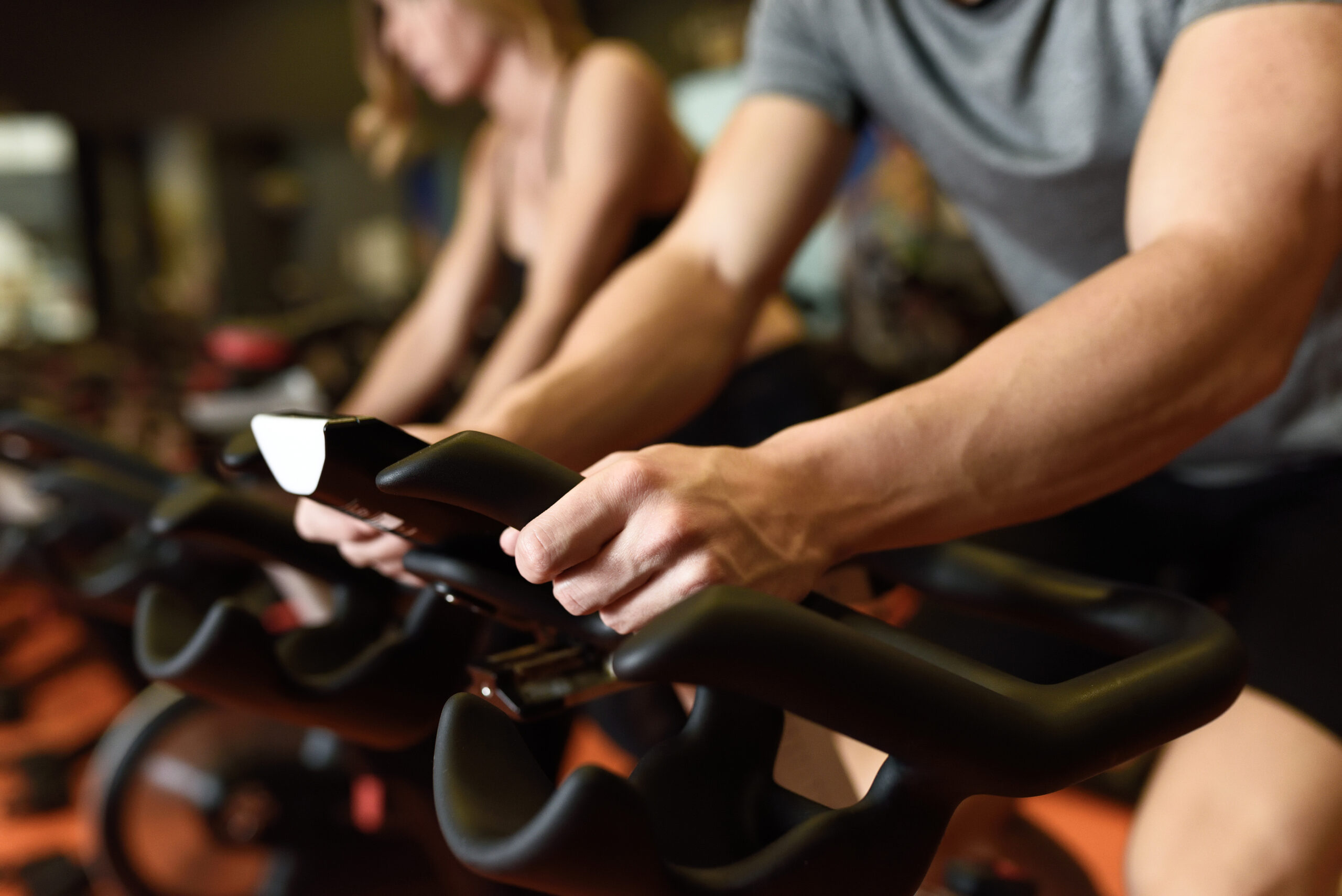In recent years, indoor cycling has surged in popularity.
The is largely due to the influx of streaming cycles and all the cool features these exercise bikes offer now, but we can’t forget the physical and mental benefits either.
Indoor cycles are compact, pretty easy on the joints, and they can offer great cardio workouts while helping improve lower body strength and overall health.
But beyond its physical benefits, the psychology behind this form of exercise reveals a profound impact on motivation, mindset, and mental well-being.
I know, the mental benefits might not be the first thing that comes to mind (see what I did there?), but whether we consciously acknowledge ’em or not, they’re still there.
Mindfulness, stress reduction, improved self confidence… cycling can help in many ways beyond simply burning calories.
Well, in this article, we’ll take a look into the intricacies of the mind-body connection when you clip into those pedals.
Motivation: The Drive Behind the Ride
Setting and Achieving Goals
Indoor cycling thrives on the foundation of goal-setting.
And unlike outdoor cycling, where the terrain can vary, indoor cycling provides a controlled environment, making it conducive to setting specific, measurable, achievable, relevant, and time-based (SMART) goals.
- Tangible Metrics: Whether it’s tracking your total distance covered in a session, monitoring your average power output, or aiming to beat your personal record during interval sprints, the metrics associated with indoor cycling provide tangible benchmarks. These quantifiable goals serve as motivators, driving riders to surpass their previous performances and strive for continuous improvement.
- Progress Tracking: Most indoor cycling platforms and classes offer performance metrics in real-time, allowing riders to monitor their progress throughout the session. Watching these metrics fluctuate based on effort, resistance, and cadence provides immediate feedback. Celebrating small victories, such as increasing resistance levels or maintaining a higher cadence, reinforces positive behavior and motivates riders to push harder.
- Goal Alignment: Beyond individual performance metrics, indoor cycling classes often incorporate themed rides or challenges, such as endurance rides, interval training, or hill climbs. These structured sessions align with broader fitness objectives, whether it’s building cardiovascular endurance, increasing muscular strength, or just enhancing overall fitness levels. Aligning individual goals with broader fitness aspirations fosters a sense of purpose and direction, motivating riders to stay committed and consistent.
Community Support
The intrinsic motivation derived from setting and achieving goals intertwines seamlessly with the extrinsic motivation fostered by community support.
- Shared Accountability: The group dynamics inherent in indoor cycling classes create a sense of accountability. Knowing that fellow riders, and sometimes friends or acquaintances, witness your commitment motivates individuals to show up, give their best effort, and persevere through challenging segments. This shared accountability cultivates a supportive environment where each participant contributes to collective progress.
- Instructor Guidance and Encouragement: The role of instructors extends beyond leading the class. They serve as motivational catalysts, offering guidance and encouragement. Through uplifting cues, motivational anecdotes, and personalized feedback, instructors empower riders to challenge themselves and achieve greatness. Their unwavering belief in each participant’s potential transcends physical boundaries, motivating riders to push beyond perceived limitations and unlock untapped potential.
- Peer Motivation and Inspiration: Beyond instructors, fellow riders play a pivotal role in fostering motivation as well. Observing other riders conquer challenges, witness improvements, and embody resilience serves as a source of inspiration. The collective energy and shared triumphs create a motivating environment where individuals uplift and empower one another. This motivation can extend beyond the studio, influencing lifestyle choices in your daily life.
In other words, the motivation behind indoor cycling emanates from the harmonious blend of individual goal-setting and community support.
And the combination of progress tracking, goal alignment, shared accountability, instructor guidance, and peer motivation can cultivate a motivational ecosystem that empowers riders to embrace challenges and pursue excellence in the real world.

Mindset: The Mental Game of Pedaling
Mindfulness and Presence
- Focused Attention: Indoor cycling demands an unparalleled level of focus and concentration. As riders clip into their pedals, the rhythmic cadence, synchronized breath work, and intentional movements cultivate a state of mindfulness. This focused attention helps create a deep connection between mind, body, and bike.
- Mind-Body Synchronization: The essence of indoor cycling lies in the seamless integration of mind and body. Each pedal stroke, resistance adjustment, and movement requires conscious awareness and intentional execution. This mind-body synchronization causes the rider to pay more attention to their body through the duration of the workout.
- Emotional Regulation: The mindfulness practice inherent in indoor cycling may help facilitate emotional regulation. By fostering present-moment awareness, riders can learn to acknowledge and navigate their emotions effectively. This emotional resilience empowers individuals to embrace discomfort and manage stressors for a more balanced emotional state.
Overcoming Mental Barriers
- Resilience Building: Whether confronting physical fatigue, mental exhaustion, or emotional turmoil, riders encounter plenty of challenges throughout their journey. The ability to navigate these obstacles and persevere through adversity can certainly help improve mental fortitude and resilience.
- Positive Self-Talk: The internal dialogue during indoor cycling can play a pivotal role in mindset development as well. Adopting a growth mindset, characterized by optimism, self-belief, and resilience, empowers riders to reframe challenges as opportunities for growth. By fostering positive self-talk, folks can learn to get past perceived limitations and unlock untapped potential.
- Visualization Techniques: Through the use of mentally rehearsing rides, envisioning success, and embodying desired outcomes, riders can create a sense of purpose and motivation. These visualization practices can help improve focus and prime the mind for peak performance.
In essence, the mindset cultivated through indoor cycling can extend past the physical act of pedaling.
With time, riders can work to improve mindfulness and presence, helping them overcome mental barriers.
Cycling also gives us an opportunity to work on other mental strategies to improve our resilience throughout the rest of our day to day life.
Mental Health Benefits: Beyond the Bike
While the physical benefits of indoor cycling are widely recognized, its profound impacts on mental health probably aren’t.
Looking beyond the cardiovascular endurance, indoor cycling can serve as a therapeutic outlet, helping riders foster emotional well-being, resilience, and mental clarity.
This occurs in a few different ways.
Stress Reduction
- Endorphin Release: One of the most renowned mental health benefits of indoor cycling is the release of endorphins. Often referred to as the body’s natural painkillers, endorphins elevate mood, alleviate stress, and induce a state of euphoria. The consistent physical exertion of indoor cycling stimulate endorphin production, creating a natural buffer against stressors.
- Cortisol Regulation: Beyond endorphin release, indoor cycling aids in regulating cortisol levels, the primary stress hormone. Chronic stress elevates cortisol levels, which can lead to anxiety, mood swings, and fatigue. Engaging in regular indoor cycling sessions helps balance cortisol production, fostering a healthy physiological state conducive to relaxation.
- Emotional Release: Indoor cycling can serve as a cathartic outlet for emotional release. The act of pedaling, accompanied by uplifting music and immersive visuals, allows riders to channel pent-up emotions, frustrations, and anxieties into productive energy. This emotional transmutation promotes self-awareness and a sense of empowerment, enabling individuals to navigate challenges with composure and grace.
Boosting Self-Esteem and Confidence
- Achievement Recognition: The incremental progress achieved through consistent indoor cycling cultivates a sense of achievement. As riders witness improvements in endurance, strength, and overall fitness, their self-esteem soars. Celebrating these milestones, no matter how small, reinforces a positive self-image, instilling confidence and self-efficacy.
- Body Positivity: Indoor cycling promotes body positivity and self-acceptance. Unlike traditional fitness environments that may emphasize aesthetic ideals, indoor cycling celebrates functional fitness and performance. The focus shifts from appearance-centric goals to embracing strength, resilience, and overall well-being, fostering a holistic approach to self-love and body acceptance.
- Empowerment: The transformative nature of indoor cycling transcends physical boundaries and empowers individuals to conquer challenges. And this newfound sense of empowerment can spread into other facets of life, from professional endeavors to personal relationships, fostering a resilient mindset and unwavering belief in one’s capabilities.
Enhanced Cognitive Function
- Neuroplasticity: Regular participation in indoor cycling promotes neuroplasticity, the brain’s ability to form and reorganize synaptic connections. The cardiovascular benefits, enhanced blood flow, and oxygenation facilitate optimal brain function, sharpening focus, enhancing memory, and promoting cognitive flexibility.
- Mental Acuity: The mental engagement required during indoor cycling, from tracking metrics to navigating interval challenges, stimulates cognitive function as well. This heightened mental acuity may lead to improved concentration and decision-making capabilities outside of the gym.
- Stress Resilience: The cognitive benefits of indoor cycling extend to stress resilience. As individuals enhance their cognitive function, they develop adaptive coping mechanisms, which help mitigate the impact of stressors. This cognitive resilience equips individuals with the tools to navigate adversity and embrace the challenges of daily life.
Overall, the mental health benefits of indoor cycling transcend the confines of the bike.
By fostering stress reduction, boosting self-esteem and confidence, and enhancing cognitive function, indoor cycling serves as a holistic therapeutic modality which can make riders more mentally tough.
Final Thoughts
The psychology of indoor cycling can go beyond the physical act of pedaling.
From improved goal setting and mindfulness to better self-esteem and stress resilience, there are a ton of mental benefits to getting your ride on.
Whether we focus on these mental processes or simply hop on and try to keep up, it’s comforting to know we’re doing some good for our brains every time we get on our bikes.
Now we know.
And by understanding this profound impact on motivation, mindset, and mental health, we can harness the power of indoor cycling to cultivate better mental health.
Pretty cool.
So, clip in, embrace the ride, and unlock the transformative power of the mind-body connection!




